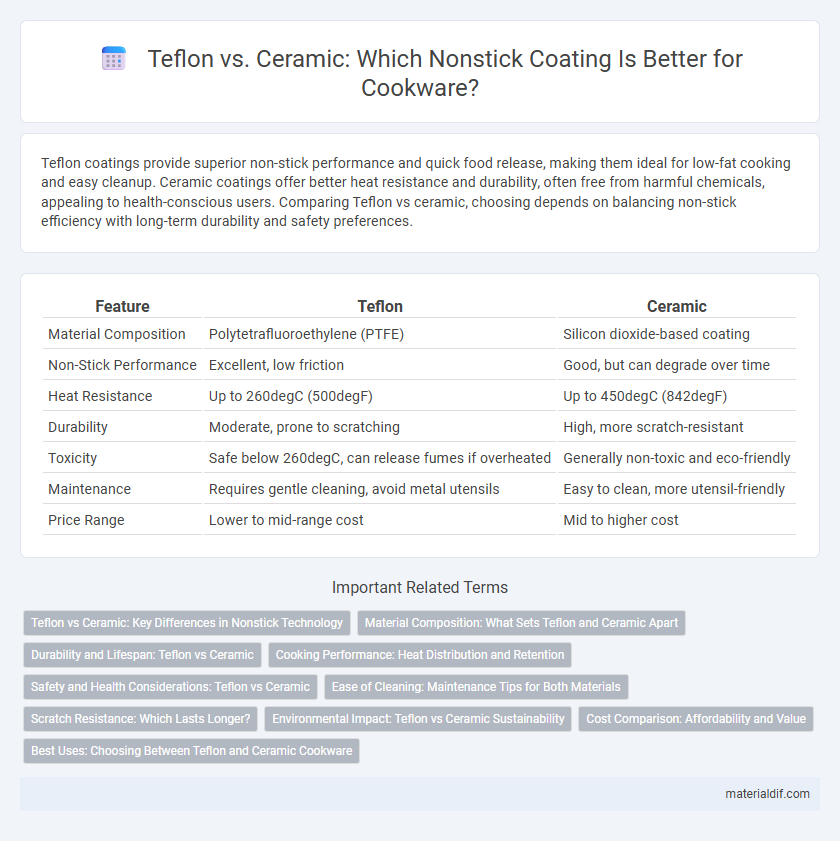Teflon coatings provide superior non-stick performance and quick food release, making them ideal for low-fat cooking and easy cleanup. Ceramic coatings offer better heat resistance and durability, often free from harmful chemicals, appealing to health-conscious users. Comparing Teflon vs ceramic, choosing depends on balancing non-stick efficiency with long-term durability and safety preferences.
Table of Comparison
| Feature | Teflon | Ceramic |
|---|---|---|
| Material Composition | Polytetrafluoroethylene (PTFE) | Silicon dioxide-based coating |
| Non-Stick Performance | Excellent, low friction | Good, but can degrade over time |
| Heat Resistance | Up to 260degC (500degF) | Up to 450degC (842degF) |
| Durability | Moderate, prone to scratching | High, more scratch-resistant |
| Toxicity | Safe below 260degC, can release fumes if overheated | Generally non-toxic and eco-friendly |
| Maintenance | Requires gentle cleaning, avoid metal utensils | Easy to clean, more utensil-friendly |
| Price Range | Lower to mid-range cost | Mid to higher cost |
Teflon vs Ceramic: Key Differences in Nonstick Technology
Teflon features a synthetic polymer coating known as polytetrafluoroethylene (PTFE), providing superior nonstick performance and high heat resistance up to approximately 260degC (500degF). Ceramic coatings, derived from inorganic minerals, offer a chemically inert and eco-friendly alternative with excellent heat tolerance but typically exhibit less durability and nonstick longevity compared to Teflon. Key differences include Teflon's smoother surface minimizing food adhesion and ceramic's porous surface requiring more careful maintenance to prevent wear and loss of nonstick properties.
Material Composition: What Sets Teflon and Ceramic Apart
Teflon is a synthetic fluoropolymer composed primarily of polytetrafluoroethylene (PTFE), known for its non-stick properties and chemical resistance. Ceramic coatings, on the other hand, are made from inorganic minerals such as silica, titanium dioxide, or aluminum oxide, offering a hard, scratch-resistant surface. The fundamental difference lies in Teflon's polymer-based composition versus ceramic's mineral-based structure, influencing their heat tolerance and durability.
Durability and Lifespan: Teflon vs Ceramic
Teflon coatings typically offer good non-stick performance but tend to degrade after 1 to 3 years due to heat and scratching, reducing durability over time. Ceramic coatings provide superior heat resistance and maintain their non-stick properties longer, often lasting up to 5 years with proper care. While ceramic pans are more durable in high-temperature cooking, Teflon is more susceptible to wear and requires more frequent replacement.
Cooking Performance: Heat Distribution and Retention
Teflon offers superior non-stick properties with even heat distribution, minimizing food sticking and allowing precise temperature control during cooking. Ceramic cookware provides excellent heat retention, enabling consistent cooking temperatures but may have less uniform heat distribution compared to Teflon. Choosing between Teflon and ceramic depends on the priority of quick heat response versus sustained heat retention for optimal cooking performance.
Safety and Health Considerations: Teflon vs Ceramic
Teflon cookware releases harmful fumes when overheated above 500degF, posing risks of polymer fume fever and respiratory issues, whereas ceramic coatings are free from PTFE and PFOA chemicals, offering a safer cooking surface. Ceramic cookware is non-toxic, heat-resistant, and does not emit hazardous gases, making it a healthier option for everyday use. Choosing ceramic over Teflon reduces exposure to potentially carcinogenic compounds linked to non-stick coatings, prioritizing long-term kitchen safety.
Ease of Cleaning: Maintenance Tips for Both Materials
Teflon cookware offers a non-stick surface that makes ease of cleaning a significant advantage, requiring gentle hand washing with mild detergents to maintain its coating. Ceramic cookware, while also non-stick, tends to be more resistant to high heat and abrasive scrubbing but benefits from soaking in warm water to remove stubborn residues. Regularly avoiding metal utensils and harsh cleaners preserves the integrity and longevity of both Teflon and ceramic surfaces.
Scratch Resistance: Which Lasts Longer?
Teflon coatings offer excellent non-stick properties but tend to scratch more easily compared to ceramic coatings, which are known for their superior scratch resistance and durability. Ceramic surfaces maintain their smooth texture longer under regular use, making them more resilient against abrasions from metal utensils and cleaning tools. Choosing ceramic cookware typically ensures a longer-lasting, scratch-resistant surface suitable for heavy-duty kitchen tasks.
Environmental Impact: Teflon vs Ceramic Sustainability
Teflon, made from polytetrafluoroethylene (PTFE), contains perfluorooctanoic acid (PFOA), a persistent environmental pollutant linked to long-term ecological harm and bioaccumulation risks. In contrast, ceramic coatings are derived from natural minerals and are biodegradable, making them more sustainable and less harmful to ecosystems. Ceramic pans also avoid the release of toxic fumes during overheating, positioning them as an eco-friendly alternative to traditional Teflon cookware.
Cost Comparison: Affordability and Value
Teflon cookware typically costs less upfront than ceramic alternatives, making it an affordable option for budget-conscious consumers. While ceramic pans often come with a higher price tag, they offer enhanced durability and chemical-free non-stick surfaces, providing long-term value. Evaluating cost per use highlights Teflon's initial affordability against ceramic's potential savings over time due to its longevity and resistance to wear.
Best Uses: Choosing Between Teflon and Ceramic Cookware
Teflon cookware excels in low to medium heat cooking, offering superior non-stick properties ideal for eggs and delicate fish, with easy cleanup and minimal oil use. Ceramic cookware withstands higher temperatures and provides a more durable, scratch-resistant surface suited for searing, sauteing, and oven use, while remaining free from PTFE and PFOA chemicals. Choosing between Teflon and ceramic depends on cooking style, heat tolerance, and preferences for environmental safety.
Teflon vs Ceramic Infographic

 materialdif.com
materialdif.com